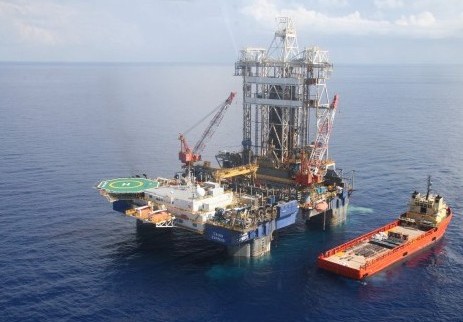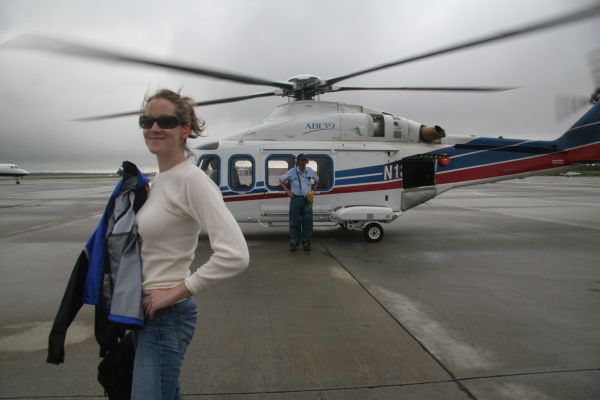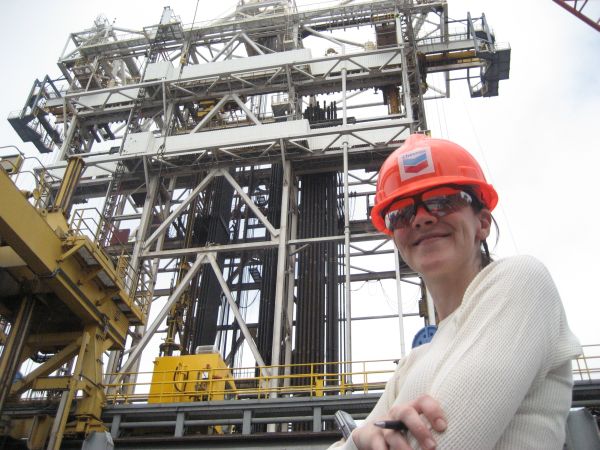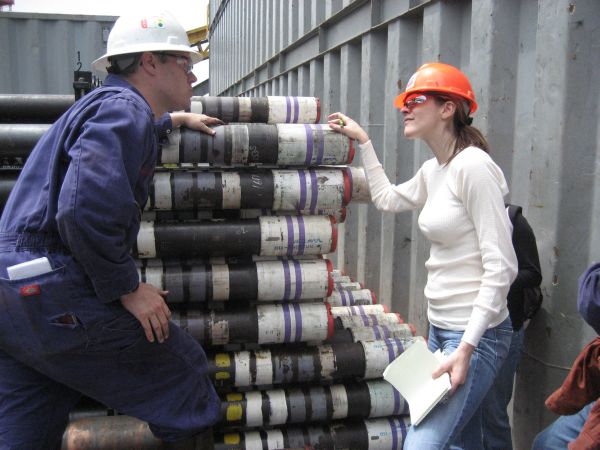 The “Cajun Express” oil rig, tapping the black gold deep beneath the Gulf of Mexico.The oil field known as “Jack” is located 175 miles off the coast of Louisiana, below 7,200 feet of water and another 30,000 feet of seabed, occupying a geological layer formed in the Cenozoic Era more than 60 million years ago. This layer — the “lower tertiary” — lies deeper under water than any other Gulf of Mexico oil discovery, which is one reason why many in the industry initially dismissed it as too remote to exploit. But in 2006, Chevron defied the odds when its engineers drilled a test well at Jack and discovered that oil could flow from this ancient sediment at profitable rates. Their success opened up a new drilling frontier — a monster oil patch holding between 3 billion and 15 billion barrels of crude. It was hailed as the largest discovery in the United States since 1968 — a discovery potentially big enough to boost national oil reserves up to 50 percent.
The “Cajun Express” oil rig, tapping the black gold deep beneath the Gulf of Mexico.The oil field known as “Jack” is located 175 miles off the coast of Louisiana, below 7,200 feet of water and another 30,000 feet of seabed, occupying a geological layer formed in the Cenozoic Era more than 60 million years ago. This layer — the “lower tertiary” — lies deeper under water than any other Gulf of Mexico oil discovery, which is one reason why many in the industry initially dismissed it as too remote to exploit. But in 2006, Chevron defied the odds when its engineers drilled a test well at Jack and discovered that oil could flow from this ancient sediment at profitable rates. Their success opened up a new drilling frontier — a monster oil patch holding between 3 billion and 15 billion barrels of crude. It was hailed as the largest discovery in the United States since 1968 — a discovery potentially big enough to boost national oil reserves up to 50 percent.
Since then, global oil companies have been pouring billions of dollars into these so-called ultradeep waters of the Gulf in pursuit of the region’s buried treasure. Jack is among a cluster of nearly a dozen new fields there — including “Blind Faith,” “Great White,” and “Cascade” — that companies are now tapping in waters from 4,000 to 8,000 feet deep and in sedimentary rock extending between 1 and 6 miles below the seabed.
Coaxing oil from such great depths poses unprecedented risks for oil drilling — and that’s why I decided to visit the area. I wanted to witness firsthand the world’s most extreme drilling territory, the Mount Everest of oil frontiers, where the industry has to tackle the tallest odds and gravest circumstances to eke out new discoveries.
 Little, psyching up for the two-hour trip to the rig.
Little, psyching up for the two-hour trip to the rig.
I set out at dawn on an April morning in a Sikorsky S-76 helicopter. The sky above the New Orleans heliport was a pea-soup green, thick with rain and pitchfork lightning. I was traveling with a Chevron executive and three of his staffers, all of us wearing regulation jumpsuits, hard hats, and steel-toed boots. The chopper lurched and shuddered in the squalls, but my travel companions nodded to the pilot to press on — this was typical weather for the Louisiana coast, and routine flying conditions.
The Gulf yields 25 percent of all U.S. oil production, and is home to more than 3,700 production platforms, most of them located in relatively shallow waters of under 2,000 feet. Many geologists believe that the ultradeep regions of the Gulf — those covered by waters greater than about 4,000 feet — hold more untapped oil reserves than any other parts of the Western world. Today, offshore rigs are capable of operating in 10,000 feet of water and boring through 30,000 feet of seabed (twice the depth they could manage a decade ago). One rig sits atop each field, thrusting its tentacles into up to a dozen wells throughout the bed. The rig pulls up oil and then pumps it back to onshore refineries via underwater pipelines.
From my helicopter window, the offshore rig known as the “Cajun Express” looked like a child’s toy — a multicolored Erector Set floating on a buoy. But once we landed and I stepped out into the salty, sunny Gulf air, the rig gave an entirely different impression, awesomely vast and imposing.
 It doesn’t look so small now, does it?
It doesn’t look so small now, does it?
We entered the boxy three-story cement building that houses the dorm rooms and offices. So austere were the surroundings — and so far removed from civilization — that I found myself heartened by the familiar details of a Snickers wrapper crumpled on the floor, a dust bunny underneath a desk, and a family snapshot tacked to an office wall — evidence that people actually do live and work on this floating city.
Rising from the concrete floor and up through the bottoms of my boots was a strange vibration. “The thrusters,” explained Paul Siegele, then director of Chevron’s offshore drilling divisions. Thrusters, he told me, are gigantic engines at each corner of the platform relentlessly pushing and pulling against the ocean currents. Picture yourself standing in shallow waters at a beach and incessantly shifting your weight to stay balanced as the waves surge and the tides ebb and flow. Thrusters do an extreme version of this in order to keep the rig “on station,” meaning within six inches in any direction of the drill’s charted entry point into the seabed below. Anchors can’t be used to moor drilling vessels at these depths — the motion of the ocean would strain even the strongest of moorings, and rigs need to be able to motor to safety in the event of a hurricane.
The thruster solution is ingenious, but it carries an astonishing energy burden: these 9,500-horsepower engines use a combined total of 27 megawatts of power when running at full capacity — enough to power about 21,000 homes. The generators that power the thrusters and keep the lights on, the electric drill turning, and the computers humming in this village at sea require about 40,000 gallons of diesel per day. It’s roughly the amount of fuel that 13,300 Hummers consume in a typical day of driving.
You have to burn fossil fuels to harvest them — that’s a reality in any drilling scenario — but the ratio of energy invested to energy gained gets slimmer as the drilling conditions get more extreme. (By “energy invested” I’m referring to all fossil fuels used to discover, drill, pump, and refine the oil and transport it to market.) During the glory days of U.S. oil production in the 1930s, an investment of 1 barrel of oil would yield a return of about 100 barrels. By 1970, when oil deposits had become scarcer and more difficult to extract and refine, the ratio had shrunk by more than half: 40 barrels of oil gained for every 1 barrel invested. By 2005, as the industry faced ever-greater limits, the ratio had diminished still further: about 14 to 1. Returns will continue to diminish, some experts argue, until we reach a 1:1 ratio — and that would spell the end of the petroleum era.
 During a tour of the rig, Little gets a look at sections of the drill shaft.
During a tour of the rig, Little gets a look at sections of the drill shaft.
Three out of four exploration wells in the ultra-deep region of the Gulf come up dry — nerve-wracking odds when the wells cost $100 million apiece, or as much as 20 times what they cost on land. And even if you hit pay dirt, there’s no guarantee of profit: In the past decade, Chevron has abandoned nearly a quarter of the successful wells it has drilled because they wouldn’t flow at profitable rates. Add to that the risks of hurricanes, powerful undersea currents that can cripple well shafts, and even routine equipment failures that can stymie operations on rigs that cost more than $500,000 a day to operate.
Given the vertiginous risks that plague ultra-deep drilling, it’s sobering to think that this frontier holds the oil industry’s best hope for finding new petroleum reserves. “The odds are incredibly low that we’re going to hit some fabulous new discovery on land,” Matthew Simmons, a leading investor and industry analyst, told me. “Everybody’s looking to the deep sea for big new finds.” To an outsider, it’s at once impressive and baffling to watch engineers burrow five miles into the earth for oil. “It has all the audacity and technological complexity of launching a space shuttle,” as Simmons put it.
If Chevron is going to throw a billion dollars into wells in this high-risk, deep-sea region — many of them doomed to failure — wouldn’t it make more sense to invest in the inexhaustible, greener technologies that will likely replace fossil fuels? Not anytime soon, according to Siegele: “Do you fly on planes? Do you drive a car? Do you use FedEx and eat imported food?” he challenged me. “What do you think delivers those products and moves those jets?” Siegele had a point: Even as innovators have been producing breakthroughs in clean cars, green buildings and renewable energy and efficiency, American oil demand on the whole has been holding steady in recent years, not declining. And even if America were to slash its oil consumption, industrial growth in China and India is pushing global petroleum demand ever higher. “So long as people need oil,” Siegele told me, “we’ll find a way to supply it.”
Technological breakthroughs have, decade after decade, revived the perpetually doomed oil industry: petroleum reserves often seemed too remote or too expensive to exploit over the last century, yet engineers invariably managed to come up with better, cheaper drilling methods. “Predicting peak oil,” Siegele told me, “is almost like predicting peak technology” — an exercise that to him seems inherently small-minded, even absurd. As for global warming, he believes technology will triumph here, too: we’ll find a way to scrub carbon from the atmosphere, rendering fossil fuels harmless to the climate.
I found the whole enterprise of deep-sea drilling doggedly ambitious, but also seemingly desperate — like an addict forcing a syringe into the earth’s innermost veins. How did it come to this — to scenarios as remote and arduous as the five-mile undersea wells drilled by the Cajun Express? How did a resource that is now so hard to come by in America become the basis of our economic survival?
This piece was excerpted and adapted from Amanda Little’s book Power Trip: From Oil Wells to Solar Cells-Our Ride to the Renewable Future, as well as from a feature published in Wired.



